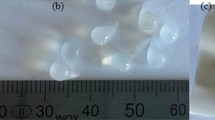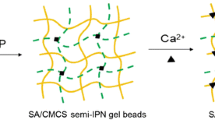Abstract
In this report, novel biopolymer hydrogels composed of sodium alginate (SA) and the oxidized sodium alginate (OSA) with an interpenetrating polymer network (IPN) structure were prepared by a combination of chemical and ionic cross-linking approaches. By using SA as the main raw material, OSA was obtained using sodium periodate. The gelation process of the IPN hydrogels was the formation of dual network: one gelatin network cross-linked by OSA with dihydrazide and another SA network cross-linked by Ca2+. The factors which affect its swelling properties were discussed. The best swelling ratio of the beads was 2300, and the swelling property was greatly affected by pH and preparation condition. The stability and swelling behavior of OSA/SA gel beads were better improved than the pure SA/Ca2+ system. The OSA/SA hydrogel beads with the pH sensitivity and stability will be a good candidate for site-specific controlled drug release carrier.











Similar content being viewed by others
References
Nguyen MK, Alsberg E (2014) Bioactive factor delivery strategies from engineered polymerhydrogels for therapeutic medicine. Prog Polym Sci 39:1235–1265
Hoffman AS (2012) Hydrogels for biomedical applications. Adv Drug Del Rev 64:18–23
Bhattarai N, Gunn J, Zhang M (2010) Chitosan-based hydrogels for controlled, localized drug delivery. Adv Drug Del Rev 62:83–99
Orive G, Castro MD, Kong H, Hernández RM, Ponce S, Mooney DJ, Pedraz JL (2009) Bioactive cell-hydrogel microcapsules for cell-based drug delivery. J Controlled Release 135:203–210
Gu F, Amsden B, Neufeld R (2004) Sustained delivery of vascular endothelial growth factor with alginate beads. J Controlled Release 96:463–472
Muhamad II, Fen LS, Hui NH, Mustapha NA (2011) Genipin-cross-linked kappa-carrageenan/carboxymethyl cellulose beads and effects on beta-carotene release. Carbohydr Polym 83:1207–1212
Abd EI-Ghaffar MA, Hashem MS, EI-Awady MK, Rabie AM (2012) pH-sensitive sodium alginate hydrogels for riboflavin controlled release. Carbohydr Polym 89:667–675
Lin YH, Liang HF, Chung CK, Chen MC, Sung HW (2005) Physically crosslinked alginate/N, O-carboxymethyl chitosan hydrogels with calcium for oral delivery of protein drugs. Biomaterials 26:2105–2113
Kim WT, Chung H, Shin I, Yam KL, Chung D (2008) Characterization of calcium alginate and chitosan-treated calcium alginate gel beads entrapping allyl isothiocyanate. Carbohydr Polym 71:566–573
Hua SB, Ma HZ, Li X, Yang HX, Wang AQ (2010) pH-sensitive sodium alginate/poly(vinyl alcohol) hydrogel beads prepared by combined Ca2+ crosslinking and freeze-thawing cycles for controlled release of diclofenac sodium. Int J Biol Macromol 46:517–523
George M, Abraham TE (2007) pH sensitive alginate-guar gum hydrogel for the controlled delivery of protein drugs. Int J Pharm 335:123–129
Darnell MC, Sun JY, Mehta M, Johnson C, Arany PR, Suo Z, Mooney DJ (2013) Performance and biocompatibility of extremely tough alginate/polyacrylamide hydrogels. Biomaterials 34:8042–8048
George M, Abraham TE (2006) Polyionic hydrocolloids for the intestinal delivery of protein drugs: alginate and chitosan—a review. J Controlled Release 114:1–14
Lonita M, Pandele MA, Lovu H (2013) Sodium alginate/graphene oxide composite films with enhanced thermal and mechanical properties. Carbohydr Polym 94:339–344
Wang Q, Zhang J, Wang A (2009) Preparation and characterization of a novel pH-sensitive chitosan-g-poly(acrylic acid)/attapulgite/sodium alginate composite hydrogel bead for controlled release of diclofenac sodium. Carbohydr Polym 78:731–737
Zhang J, Wang Q, Wang A (2010) In situ generation of sodium alginate/hydroxyapatite nanocomposite beads as drug-controlled release matrices. Acta Biomater 6:445–454
Bae YH, Kim SW (1993) Hydrogel delivery systems based on polymer blends, block co-polymers or interpenetrating networks. Adv Drug Del Rev 11:109–135
Balakrishnan Jayakrishnan (2005) Self-cross-linking biopolymers as injectable in situ forming biodegradable scaffolds. Biomaterials 26:3941–3951
Jeon O, Alt DS, Ahmed SM, Alsberg E (2012) The effect of oxidation on the degradation of photocrosslinkable alginate hydrogels. Biomaterials 33:3503–3514
Lü SY, Liu MZ, Ni B (2010) An injectable oxidized carboxymethylcellulose/N-succinyl-chitosan hydrogel system for protein delivery. Chem Eng J 160:779–787
Widjaja LK, Bora M, Chan PNPH, Lipik V, Wong TTL, Venkatraman SS (2014) Hyaluronic acid-based nanocomposite hydrogels for ocular drug delivery applications. J Biomed Mater Res Part A 102:3056–3065
Zhao H, Heindel ND (1991) Determination of degree of substitution of formyl groups in polyaldehyde dextran by the hydroxylamine hydrochloride method. Pharm Res 8(3):400–409
Shoichet MS, Li RH, White ML, Winn SR (1996) Stability of hydrogels used in cell encapsulation: an in vitro comparison of alginate and agarose. Biotechnol Bioeng 50:374–381
Bidarra Sílvia J, Barrias Cristina C, Granja Pedro L (2014) Injectable alginate hydrogels for cell delivery in tissue engineering. Acta Biomater 10:1646–1662
Chen F, Tian M, Zhang DM, Wang JY, Wang QG, Yu XX, Zhang XH, Wan CX (2012) Preparation and characterization of oxidized alginate covalently cross-linked galactosylated chitosan scaffold for liver tissue engineering. Mater Sci Eng C 32:310–320
Wang YY, Peng WZ, Liu X, Zhu MH, Sun T, Peng Q, Zeng Y, Feng B, Zhi W, Weng J, Wang J (2014) Study of bilineage differentiation of human-bone-marrow-derived mesenchymal stem cells in oxidized sodium alginate/N-succinyl chitosan hydrogels and synergistic effects of RGD modification and low-intensity pulsed ultrasound. Acta Biomater 10:2518–2528
Smidsrod O, Skjak-Braek G (1998) Alginate as immobilization matrix for cells. Adv Drug Del Rev 31:267–285
Kato Y, Onishi H, Machida Y (2001) Lactosaminated and intact N-succinyl-chitosans as drug carriers in liver metastasis. Int J Pharm 226:93–106
Tan H, Chu Constance R, Payne Karin A, Marra Kacey G (2009) Injectable in situ forming biodegradable chitosan-hyaluronic acid based hydrogels for cartilage tissue engineering. Biomaterials 30:2499–2506
Yang J, Chen J, Pan D, Wan Y, Wang Z (2013) pH-sensitive interpenetrating network hydrogels based on chitosan derivatives and alginate for oral drug delivery. Carbohydr Polym 92:719–725
Acknowledgments
The authors are grateful for the financial support from the National Natural Science Foundation of China (No. 81401510), the Modernization Engineering Technology Research Center of Ethnic Minority Medicine of Hubei province (2015ZY001) and the academic team of South-central University for Nationalities (CZW15017).
Author information
Authors and Affiliations
Corresponding author
Rights and permissions
About this article
Cite this article
Hu, Y., Chen, T., Dong, X. et al. Preparation and characterization of composite hydrogel beads based on sodium alginate. Polym. Bull. 72, 2857–2869 (2015). https://doi.org/10.1007/s00289-015-1440-2
Received:
Revised:
Accepted:
Published:
Issue Date:
DOI: https://doi.org/10.1007/s00289-015-1440-2




